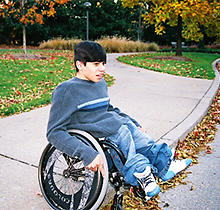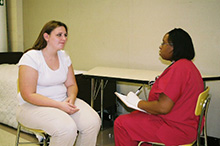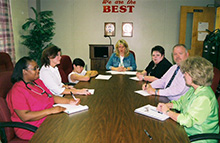What is Ms. Valens’s role as a school nurse?
Page 3: Participates in Section 504 Planning and Individualized Education Programs
 So that they can obtain an appropriate education in the least-restrictive environment, students with health conditions typically have either a 504 plan or an individualized education program (IEP) in place. Section 504 of the Rehabilitation Act of 1973 prohibits discrimination against individuals with disabilities, ensuring that children with disabilities have equal access to public education. The 504 plan specifies accommodations and modifications that enable a child to attend school with his or her peers.
So that they can obtain an appropriate education in the least-restrictive environment, students with health conditions typically have either a 504 plan or an individualized education program (IEP) in place. Section 504 of the Rehabilitation Act of 1973 prohibits discrimination against individuals with disabilities, ensuring that children with disabilities have equal access to public education. The 504 plan specifies accommodations and modifications that enable a child to attend school with his or her peers.
When his or her ability to learn is also affected by the disability, the student may be eligible for special education services, which includes an IEP. This working document specifies learning goals, in addition to any accommodations and modifications the student may need to attend school.
Back to the Challenge: Dylan in Detail
 Because his disability causes him to miss a great deal of school, Dylan has an IEP. The more school he misses, the more he falls behind, adversely affecting his learning. He qualifies for related services and will be working with Ms. Valens, the school nurse, to develop supportive accommodations so that he will miss fewer days of school and therefore improve his learning outcomes. For example, the school nurse will need to further educate him about how to prevent UTI infections. The school nurse will also need to work with Dylan’s teachers to allow him more time to attend to his catheter. In order to write an IEP accurately tailored to Dylan’s needs, the IEP team should be made up of the people most acquainted with Dylan’s disability and how it affects his academic performance. These individuals would include Dylan himself, his parents, the school nurse, and his teachers.
Because his disability causes him to miss a great deal of school, Dylan has an IEP. The more school he misses, the more he falls behind, adversely affecting his learning. He qualifies for related services and will be working with Ms. Valens, the school nurse, to develop supportive accommodations so that he will miss fewer days of school and therefore improve his learning outcomes. For example, the school nurse will need to further educate him about how to prevent UTI infections. The school nurse will also need to work with Dylan’s teachers to allow him more time to attend to his catheter. In order to write an IEP accurately tailored to Dylan’s needs, the IEP team should be made up of the people most acquainted with Dylan’s disability and how it affects his academic performance. These individuals would include Dylan himself, his parents, the school nurse, and his teachers.
For both the 504 plan and the IEP, a multidisciplinary team—which often includes the student, parents, teachers, and the related service provider—determines whether a child is eligible for related services. In order to successfully manage school-based healthcare for students, the school nurse (a crucial member of this multidisciplinary team) should take the lead in planning these services in order to ensure the health and educational success of students.
Involvement in the IEP Process
 As a member of the multidisciplinary education team, the school nurse is responsible for a number of tasks. First, he or she is involved with identifying and assessing students for health services. He or she does this by collecting information about the student’s health condition to bring to IEP meetings and by providing medical background about the student’s health-related needs. Second, the school nurse assists as needed in the planning and implementation of IEPs by delivering necessary health services. The IEP team determines which health services are necessary to allow a student with disabilities to attend school and to participate fully in educational activities. The school nurse is then responsible for coordinating and/or providing these services. He or she also continually monitors and evaluates the health services being delivered and adjusts them as necessary.
As a member of the multidisciplinary education team, the school nurse is responsible for a number of tasks. First, he or she is involved with identifying and assessing students for health services. He or she does this by collecting information about the student’s health condition to bring to IEP meetings and by providing medical background about the student’s health-related needs. Second, the school nurse assists as needed in the planning and implementation of IEPs by delivering necessary health services. The IEP team determines which health services are necessary to allow a student with disabilities to attend school and to participate fully in educational activities. The school nurse is then responsible for coordinating and/or providing these services. He or she also continually monitors and evaluates the health services being delivered and adjusts them as necessary.
Click here to listen to Judy Harrigan, RN, describe the roles of the school nurse in the IEP process (time: 1:40).
Judy Harrigan, RN, MSN, FNASN
Former health services consultant
Colorado Department of Education

Transcript: Judy Harrigan, RN, MSN, FNASN
The nurse is involved in determining the needs of the student and helping to lay out the plan for the IEP that will include adaptations and modifications for hearing augmentation or various things that might have to do with the child’s individual health needs. The nurse is involved in developing an individualized healthcare plan that becomes an additional tool to be used with the IEP. And, of course, the school nurse would be involved in providing direct services that would be specified in the IEP that may be related to physical needs: things like tube feedings or medication administration or other health-related procedures. Certainly, communication with parents is one of the roles of the school nurse, especially as related to the health needs. Another thing that the nurse may do involves meeting with the students and determining how they’re getting along in school and whether they need to have any accommodations or modifications in addition to those that have already been identified. The next thing the nurse would do would be really monitor and evaluate and make revisions to the plan. As the child gets integrated into the school, it’s likely that things will change and that there need to be some changes made, and evaluation is a key part of that role. And as a member of an IEP team, often times the school nurse is asked to explain what medical terms mean or what medical information might impact the child in the school setting.
The table below outlines the responsibilities of the school nurse in the management of healthcare needs for students with disabilities and in the IEP process.
| Identification and Assessment |
|
| Planning and Implementation |
|
| Monitoring and Evaluation |
|
As part of the IEP for a student with special healthcare needs, the school nurse may develop an Individualized Healthcare Plan (IHP) or an Emergency Care Plan (ECP). The IHP includes information about the student’s health needs and what nursing interventions will be implemented to address these needs. It promotes solid planning, coordination, continuity, and evaluation of the student’s care.
An ECP, which may be created as part of the IEP or IHP, provides directions about what to do when an emergency arises. The ECP describes the child’s medical condition, the medications he or she is taking, and the correct emergency procedures. Because the school nurse is not always on site, the plan is available to school personnel and emergency care providers when an urgent situation arises.
Back to the Challenge: Dylan in Detail
 Though Ms. Worley was familiar with Dylan’s IEP and his daily healthcare needs, she remained frustrated. Click below to review a copy of Dylan’s IHP.
Though Ms. Worley was familiar with Dylan’s IEP and his daily healthcare needs, she remained frustrated. Click below to review a copy of Dylan’s IHP.
As you learned in the Challenge, Ms. Worley had received a copy of Dylan’s ECP. Ms. Valens, Ms. Worley, and other school staff (including Mrs. Carpenter, the unlicensed assistant) were scheduled to meet to review the emergency care plan procedure. However, in the meantime, Dylan had a seizure while at the school. Click below to review Dylan’s ECP to learn about the procedures that should be followed and those that should not be implemented when Dylan is having a seizure.
|
INDIVIDUAL HEALTH PLAN Seizure Disorder Seizures are caused by abnormal electrical activity in the cerebral neurons. There is no “cure,” but the seizure activity can be controlled with medication. The goal is to control seizures on the lowest medication dose possible. Generalized Tonic-Clonic seizures, also known as Grand Mal seizures, are the most dramatic and frightening of seizures, and they can last longer than other types of seizures.
PRIMARY DIAGNOSIS: Sacral Agenesis– Absence, failure of formation, or imperfect development of the lower portions of the spinal column and pelvis. Urinary tract infections due to bladder complications; occasional seizures
|
|||||||||||||||||||||||||||||||||||||||
|
Post This Page Only Emergency Procedures: Dylan
|
|||||||||

expert-name”>Christy Brookshire, RN
Tolbert Elementary School
Calhoun, Georgia
Christy Brookshire, RN, school nurse and a public-health-center specialist, discusses the importance of sharing IHP information with IEP members (time: 0:59).
Christy Brookshire explains the process she uses to gather information for a student’s ECP (time: 0:50).
Transcript: Christy Brookshire, RN
The importance of sharing IHP information with IEP members
My role is to have a professional opinion about the illness that the child may have. I have a child here with Von Willebrand disease, which is a bleeding disorder, and just a few weeks ago we had her meeting. One thing that I mentioned in the meeting (I had seen her last year for falling in P.E.) was she was wearing wedge tennis shoes. And, to prevent injury, we needed to address her safety in P.E. Her mother wants her to participate in P.E., which is very understandable. But she has to go home and have injections if she were to get injured at school and have a bleed here. So that’s not something one would think about: With a medical condition, you’re not thinking about their tennis shoes. But that is something that I felt was very important in her safety while she’s here at school.
I collaborated with the teacher and we discussed with the parent: If she really, really loves those tennis shoes, she can wear those tennis shoes to school that day, but she needs to bring another pair in her book bag to put on in P.E.
Transcript: Christy Brookshire, RN
Process used to gather information
If we do have a new student enroll with healthcare needs, the first thing we do is we have them fill out their clinic card, and if any medical conditions are listed then I go through and find out what they are and what plan of care the mother usually has going. I also have a care plan, it’s a blank care plan, that that mom has to take to the physician and have that physician fill out, explaining the condition of the child, what steps are to be taken on a daily basis under normal circumstances, and then what emergency steps are to be taken if a condition should arise while the child was here at school.
I do have the emergency healthcare plan for children who have severe allergies. I actually have a little child that has peanut allergies. We do have that filled out by her physician. Then that’s posted in my office and in the lunchroom so that the lunchroom workers know what to do if something were to happen.
Keep in Mind
It is important to note that not all students with disabilities will have special healthcare needs and therefore require an IHP or an ECP; the needs of each individual should be assessed to determine whether these plans are necessary for the student to participate in and benefit from the educational program.
Activity
For each student, click on the ECP link to read his or her ECP, then read the scenarios below and think about what you would do in each circumstance.

Leon has asthma, which is controlled with medication via an inhaler. During after-school tennis practice, Leon had an asthma attack and experienced difficulty breathing. When Leon realized that he had left his inhaler at home, he panicked, exacerbating his attack. Coach Cole called the school nurse’s office to see whether Leon’s parents had supplied an extra inhaler, but the nurse had already left for the day. What should Coach Cole do next?
According to Leon’s ECP, Coach Cole should call 911 because the school nurse is unavailable. The ECP also contains the emergency phone numbers for Leon’s parents, who should be notified as soon as possible. To address future situations when the school nurse is not on site, school personnel, including the school nurse, and the family might want to revise Leon’s ECP.
|
Emergency Care Plan for Leon Robinson
Asthma Asthma attacks can be fatal. Do NOT delay response.
Asthma is a chronic condition that causes spasms of the bronchial tubes. It can cause persistent coughing, wheezing, or shortness of breath. It is managed with inhaler medications, which provide relief and prevent emergencies.
Signature_________________________________ Date_________________ |
||||||||||||||||||||||||||||||

Kasey has a severe allergy to bee stings that results in hives, facial swelling, and difficulty breathing. During a field trip, a honeybee stung Kasey. Though her face immediately swelled and she had difficulty breathing, she was able to self-administer the EpiPen. The injection reduced the swelling and helped to stabilize her breathing. Because Kasey looked like she was feeling better, the teacher wondered whether she needed to contact the school nurse right away or just wait until they returned from the field trip. What should she have done?
EpiPen is a temporary measure, lasting for a short period of time, so Kasey should have been taken to the emergency room right away. Once she was receiving treatment from the physicians, the teacher could have called the school nurse to alert her to the situation. It is always a good idea to carry copies of ECPs on field trips and to have file copies within easy reach in the classroom.
|
Emergency Care Plan for Kasey Thomas Severe Allergy (Honey-Bee and Wasp Stings) Allergic reactions can be fatal. Do NOT delay response.
|
|||||||||||||||||||